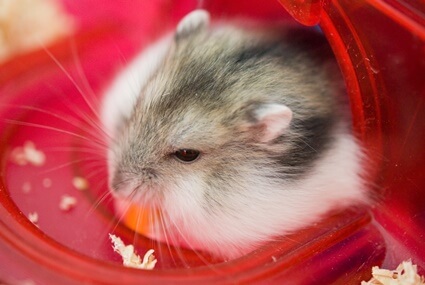For wild hamsters, tunnels are a means of escape and livelihood. Hamsters use the tunnels to stay out of sight of predators, take shelter from the weather, store their food, and sleep.
In captivity, tunnels have largely the same purpose as in the wild. Hamsters use their tunnels to escape when they feel threatened, hoard food, and sometimes sleep. However, hamsters will often sleep huddled up in the corner of their cage instead of in their tunnels.
Because the environment in captivity is much different from their natural environment, the tunnels sometimes serve other purposes, such as entertainment.
Do Hamsters Dig Tunnels?
Hamsters dig tunnels in the wild for protection and shelter. Hamsters are easy prey for many other animals and the underground tunnels or burrows they dig allow them a safe place to live.
Hoarding Food and Safety
Aside from merely escaping weather conditions and predators, hamsters use their tunnels to store the food they hoard.
According to the American Journal of Physiology, hoarding food allows hamsters to remain underground and still have an adequate supply of food to live off when weather conditions on the surface are less than ideal or when predators are nearby.
They also state that hoarding food in the tunnels comes in handy when food sources nearby are limited, and they’d have to travel further to forage.
Traveling too far from their tunnels can be dangerous due to lurking predators or getting caught in bad weather. Having the supply of food on hand in the safety of their tunnels gets them by until the threats have moved on or until they can move to an area with richer food sources.
Tunnel Design
The tunnels that hamsters create can be quite intricate, often with tunnels expanding off a main chamber.
Usually, they dig a tunnel from the ground’s surface until they’ve reached a safe distance. Then, they’ll create the main chamber where they may store their main food hoard.
The hamsters may dig several other tunnels that branch off the main chamber where they store other hoards of food, sleep, or keep their babies safe.
Unfortunately, due to the limited size of many cages, captive hamsters are usually unable to dig tunnels to that extent. The bedding in most hamsters’ cages isn’t deep enough to allow them to dig such intricate tunnels.
They may be able to burrow down a little, but mostly, they’d have to do with artificial tunnels that you supply.

Why Do Hamsters Like Tunnels?
Hamsters in captivity like digging and running through tunnels because it keeps them occupied. Aside from running on a wheel, playing in the tunnels is one of their favorite activities.
According to Applied Animal Behaviour Science, three groups of hamsters were kept in cages containing different depths of bedding of 10, 40, and 80 centimeters, and their behavior was observed.
The hamsters kept in cages with shallow bedding of 10 centimeters couldn’t burrow and create tunnels.
This caused all the hamsters in these cages to exhibit restless behavior, which included continual gnawing on the wires of the cages and high wheel-running activity.
All the hamsters in cages with deep bedding of 40-80 centimeters were able to burrow, create tunnels, and occupy them.
None of these hamsters were ever seen gnawing on the wires of the cages, and they ran on their wheels less than the hamsters with the 10-centimeter bedding.
This information should be enough to tell you that hamsters need tunnels and use them for survival, even in captivity.
Because cage sizes and space limit the amount of bedding you can provide to your hamsters in their cages, it’s important to give them artificial tunnels to keep them occupied.
These artificial tunnels can provide them with a place to create their nests, keep their food hoard, sleep, and escape when they feel threatened.
Types of Artificial Tunnels
If it’s impossible to get a larger hamster cage with deeper bedding for making tunnels, you’ll need to create or buy pre-made tunnels for your hamster.
Creating Tunnels
The size of your hamster will determine what you can use to create tunnels. Creating tunnels for dwarf hamsters will be much easier than for golden Syrian hamsters.
Paper Rolls
Tunnels for dwarf hamsters can be made with simple household things like toilet paper rolls and paper towel rolls.
Most dwarf hamsters are small enough to fit through the rolls with no issues. Adult Syrian hamsters are likely too big to fit through them.
Potato Chip Cans
You can also use the cans that many potato chips come in, like Pringles potato chips. You can put the can in the cage the way it is, creating a one-way tunnel.
This would probably work better for dwarf hamsters so they could easily turn around in it to get back out.
You can also cut the closed end off so both ends are open, allowing your hamster to run through it.
Plastic Piping
You can grab plastic pipes of different sizes and lengths from a hardware store and build your hamster a tunnel system that will closely replicate the kind of tunnels hamsters create in the wild.
You can build it so there’s a tunnel leading to the main chamber with other tunnels branching off it. How extravagant you get with this tunnel system will depend on how big your hamster’s cage is.
Since plastic piping comes in various sizes and lengths, you can build a tunnel system that works for small or large hamsters.
Buying Tunnels
Another option would be to buy pre-made tunnels from a pet store or online. There are many options to choose from this way:
Chewable tunnels and Tubes
There are a bunch of tunnels and tubes you can buy that are designed so your hamster can run through them and chew on them.
Choosing one of these options means that the tunnel isn’t likely to last long because your hamster will chew it up, but it’ll give your hamster yet another activity to keep it occupied.
Bendable Plastic tube
You can buy plastic tubes that are bendable and stretchable, similar to the design of the bendy and stretchy parts of beverage straws.
Because they’re bendable and stretchable, you can position them any way you want in your hamster’s cage. The tube could be straight, U-shaped, or zig-zag style.
These tubes are made with durable plastic, so they’ll hold up to heavy use and last much longer than other types of tunnels.
Ceramic tunnel
Ceramic tunnels are extremely durable and chew-proof, so they’ll last a long time.
You can get straight ones with side entrances, corner tunnels, and tunnels with openings at each end, as well as an opening at the top so your hamster can climb in and out.
Benefits of Tunnels for Hamsters
Tunnels are an important part of hamsters’ natural habitats. Even when born in captivity, their instinct is to dig, burrow, and create tunnels.
Being able to dig tunnels allows your hamster to stay occupied. It excites hamsters. It lets them scratch an itch that they naturally want to scratch. Tunnels benefit hamsters by:
- Satisfying their instincts
- Providing them with a safe personal space
- Giving them a place to safely hoard their food
- Allowing them to stay entertained
- Giving them a sense of purpose
- Providing them with physical exercise and mental stimulation
- Helping to calm their behavior

Are Tunnels Bad for Hamsters?
Overall, tunnels are good for hamsters. However, there can be bad situations associated with the tunnels.
Gets Stuck
If the tunnel is too small, your hamster could get stuck inside. Before placing a tunnel or tube in your hamster’s cage, you need to make sure it’s a safe size.
Confirm that the tube is bigger than your hamster and that your hamster can freely run through it without any issues.
Too Steep
If you have a tunnel that goes upwards, make sure it isn’t too steep for your hamster to climb. You can have a tunnel at an incline, but ensure it’s a gradual incline that your hamster can easily maneuver.
Dirty
Tubes and tunnels will get dirty quickly, so you’ll need to clean them regularly. Neglecting to clean them can lead to bacterial growth, which could make your hamster sick.
Also, some tubes and tunnels will get dirty easier than others, depending on the material they’re made from. Frequently check the tubes and tunnels to see if they need to be cleaned.
Suffocation
If there isn’t enough airflow through the tunnels or tubes, your hamster could end up suffocating inside them, especially if it decides to nap in one.
Even if you think the tube or tunnel is big enough to allow for sufficient airflow, create air holes throughout. So, you may have to create a few air holes yourself using a drill.





